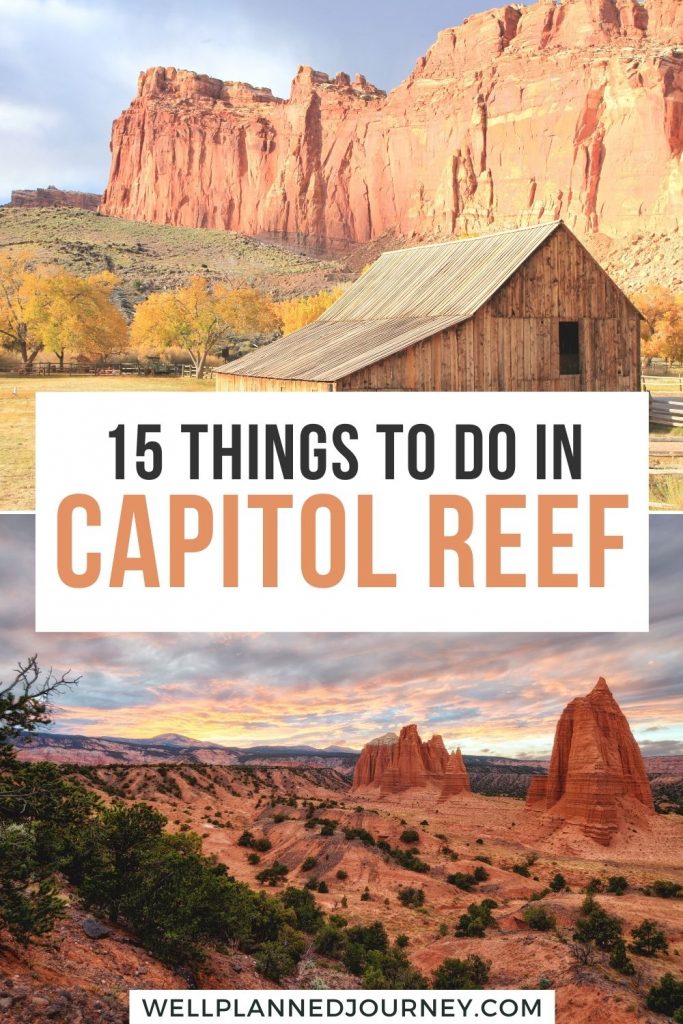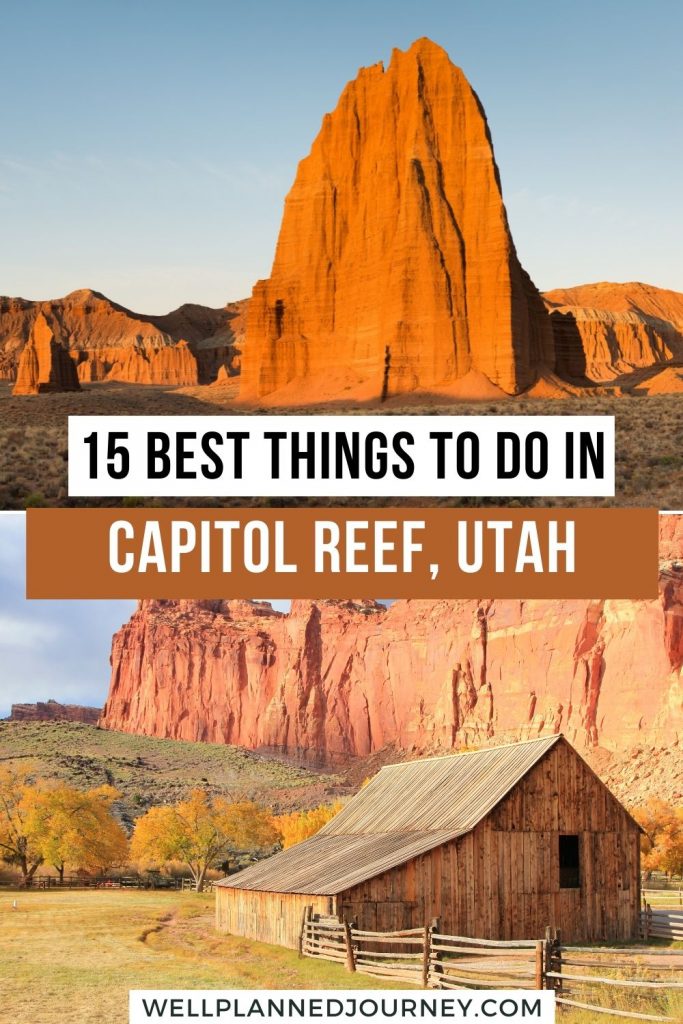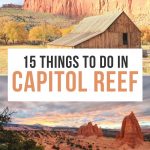Capitol Reef National Park is the least visited of Utah’s “Mighty 5” national parks. But while it doesn’t get as many visitors as neighboring Zion, Bryce Canyon, or Arches, it has plenty to offer and belongs on your Utah road trip itinerary.
This southern Utah national park provides a unique mix of historical landmarks and stunning landscapes.
In this guide, I’m covering the 15 best things to do in Capitol Reef National Park. From hikes to scenic drives, you’ll find no shortage of spectacular things to do in Capitol Reef.
In this post, you’ll also find tips on how to get to Capitol Reef, the best time to visit, where to stay near all the top landmarks, and recommendations to make your trip as seamless as possible.
Ready to start planning your trip to Capitol Reef National Park? Let’s dive in!
This post may contain affiliate links, where I may receive a small commission at no additional cost to you. Read more in this disclosure policy.
Capitol Reef At-A-Glance
Before diving in, here are a few highlights to help you plan your trip:
- Best Time to Visit: Spring or Fall are the best times to visit thanks to mild weather, perfect for hiking. Avoid crowds by visiting in March or November, on either end of peak season (just be sure to bundle up as it will be chilly!).
- Where to Stay: If you’re looking to stay in the park, your only option is camping as the park does not have a lodge. Stay outside the park in nearby Torrey, Utah at the Capitol Reef Resort or Cougar Ridge Lodge.
- How to Get There: The closest airports are in Salt Lake City, about 3.5 hours away, or Las Vegas, about 5 hours away. Use Expedia to browse flights and find the best price.
- How to Get Around: The easiest way to get around Capitol Reef is in your own car. Use Expedia to browse deals on rental cars or rent an RV or campervan with Outdoorsy.
- Best Self-Guided Tour: My favorite way to learn more about the park is with GyPSy Guides, a narrated self-guided tour perfect for road trips and scenic drives. The Capitol Reef Guide and the Utah “Mighty 5” Bundle both provide incredible commentary and detail about the history and geology of Capitol Reef.
- Don’t Forget: Be sure to get an America the Beautiful National Park Pass ahead of time. This $80 pass is valid for 12 months and get you into all 400+ national park sites (including Capitol Reef!).
About Visiting Capitol Reef National Park
Capitol Reef National Park is the second biggest national park in Utah, second only to Canyonlands National Park near Moab.
But unlike other national parks, parts of Capitol Reef are separated by the massive geological formation, the Waterpocket Fold.
The park wraps around the Waterpocket Fold formation. Capitol Reef runs predominantly north to south, at 60 miles long but only 6 miles wide.
There are three central park districts in Capitol Reef: Fruita Historic District, Cathedral Valley District, and the Waterpocket Fold.

Fruita Historic District is the most-visited and most accessible part of Capitol Reef National Park. Many of Capitol Reef’s top attractions are located in this park area, just off Highway 24.
Here you’ll find historic buildings from the Mormon homestead, the Capitol Reef Visitor Center, and several hikes and scenic drives.
Cathedral Valley District is a more remote part of Capitol Reef National Park. In the rugged landscape north of Highway 24, you’ll find towering rock formations, impressive scenic drives, and the famed Temple of the Sun and Moon.
If you have several days in Capitol Reef and an AWD vehicle, I highly recommend exploring this off-the-beaten-path area.
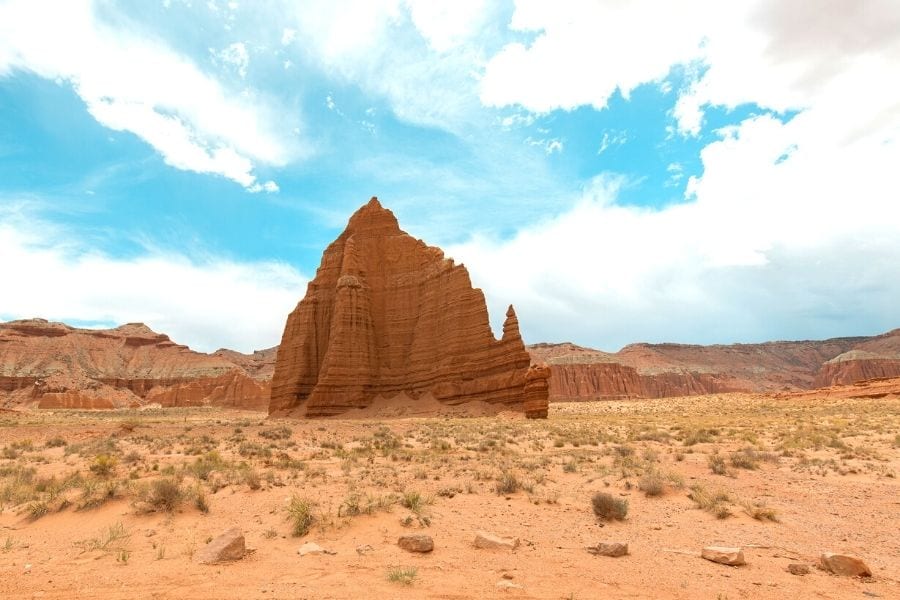
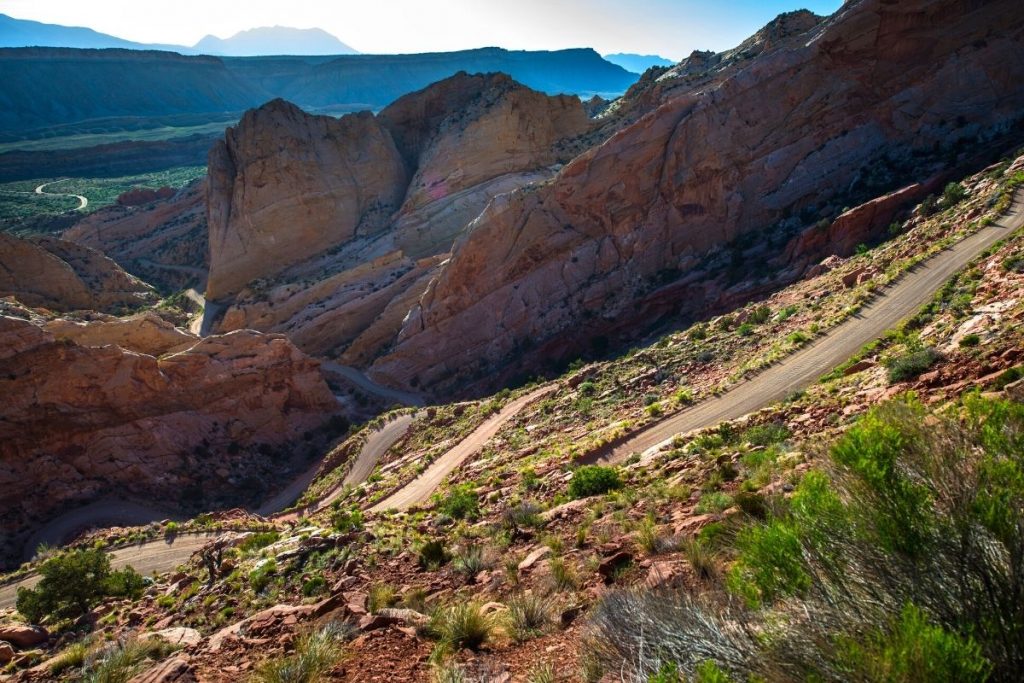
While the Waterpocket Fold passes through both the Fruita and Cathedral Valley districts, I consider the “Waterpocket Fold” district the rugged, narrow, impassable area south of the Fruit District.
To access this part of the park, you’ll need AWD and a desire to head into the wilderness. The best way to see the Waterpocket Fold is on the Burr Trail Scenic Byway coming in from the south near Highway 95.
Capitol Reef National Park Activities Entrance Fees
Capitol Reef National Park charges a $20 entrance fee per vehicle to enter the famous Capitol Gorge Scenic Drive in the Fruita District.
However, if you’re only visiting the Waterpocket Fold or Cathedral Valley areas, you won’t pass through an entrance station and won’t be required to pay the fee.
Unlike other national parks, there is no official entrance station. Instead, visitors are expected to self-pay at either the visitor center or the north end of the Capitol Gorge Scenic Drive.
Are you visiting multiple national parks in the next year? The America the Beautiful National Park Pass gets you into 400+ national park sites, including all 63 national parks, for 12 months!
Get your national park pass ahead of time for only $80.
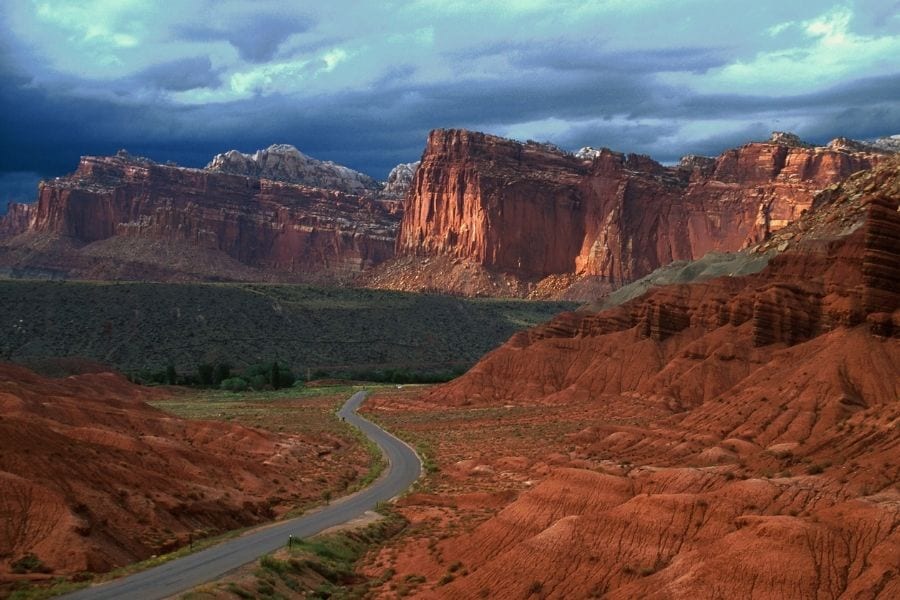
How to Get to Capitol Reef National Park
The most visited area of Capitol Reef National Park is the Historic Fruita District, roughly 20 minutes east of the town of Torrey along Highway 24.
Capitol Reef National Park is a few hours drive from neighboring national parks and just under 4 hours from Salt Lake City, Utah.
If you’re flying to visit Capitol Reef, the closest major airport is Salt Lake City International Airport (SLC), located about 4 hours away.
However, if you’re making a road trip to all of Utah’s parks, you can also consider flying into McCarran International Airport in Las Vegas (LAS).
I use Expedia to find the best flight prices and compare routes. Once you find your flight, you can book directly through Expedia to save money, but still enter your frequent flyer numbers to get points!
If you need a rental car, I also recommend using Expedia to find the best deals across brands like Avis, Hertz, Enterprise, Budget, and more.
To get to Capitol Reef, here are the driving distances and times from other popular destinations in Utah:
- Bryce Canyon National Park: 120 miles, 2 hours 20 minutes
- Moab (and Arches/Canyonlands National Parks): 150 miles, 2 hours 25 minutes
- Zion National Park: 220 miles, 3 hours 50 minutes
- Salt Lake City: 225 miles, 3 hours 40 minutes
- Las Vegas: 335 miles, 5 hours 25 minutes
Read More: 3 Days in Zion and Bryce Canyon
Where to Stay Near the Best Things to Do at Capitol Reef
Capitol Reef National Park does not have an in-park lodge. To stay in the park, you’ll need to stay at one of the park’s campgrounds:
- Fruita Campground in the Fruita Historic District: open year-round (reservable six months in advance from March to October)
- Cathedral Valley Primitive Campground in the Cathedral Valley District: open year-round on a first-come, first-serve basis
- Cedar Mesa Primitive Campground near the Waterpocket Fold area off Notom-Bullfrog Road: open year-round on a first-come, first-serve basis
Most visitors stay at hotels in nearby towns, like Torrey, or resorts just outside the park along Highway 24.
This interactive map can also help you search all the available hotels and rental properties near Capitol Reef National Park! Simply scroll and click the map below to see what is available!
These are the best hotels near Capitol Reef National Park:
- Capitol Reef Resort, a luxury resort stay with a safari just outside the park
- Red Sands Hotel, a luxury hotel in Torrey with an onsite restaurant and indoor pool
- Cougar Ridge Lodge, luxury villas and suites with private hot tubs and mountain views
- The Noor Hotel, a budget-friendly hotel in Torrey with an onsite restaurant and bar
- Austin’s Chuckwagon Motel, a budget-friendly motel with an outdoor pool and cafe in the heart of Torrey

Best Time to Visit for Hiking in Capitol Reef
While Capitol Reef National Park is open year-round, the best time to visit is Spring or Fall. These seasons see fewer crowds and more comfortable temperatures, particularly in early Spring and late Fall.
Here’s a quick overview of what to expect during each season in Capitol Reef National Park:
- Spring: Temperatures are warm but not unbearably hot during the day, perfect for hiking. In the Spring, crowds are lower ahead of the peak season. The orchards in the Fruita District bloom, making for a beautiful contrast with the surrounding red rock landscape. May is the busiest month in Capitol Reef.
- Summer: By early summer, temperatures are hot, often in the 80s and 90s. While not as busy as late Spring, July to August still see over 4,000 visitors per day. Plan to do activities around sunrise or sunset to avoid the hottest part of the day. Harvest season for many fruits in the Fruita Orchard begins in summer!
- Fall: As temperatures decline in September, crowds pick back up. In fall, the orchards are in harvest season for apples (you can pick fruit!), and the Cottonwood trees turn bright yellow! Fall is by far my favorite time to visit Capitol Reef National Park (and a great time to visit nearby Zion and Bryce Canyon).
- Winter: The winter months in Capitol Reef are beautiful, but snow and freezing temperatures limit your ability to hike. The primary benefit of visiting in the winter is the minimal crowds and the beautiful contrast of red, rocky landscapes and white snow.
Read More: Best Time to Visit Zion National Park
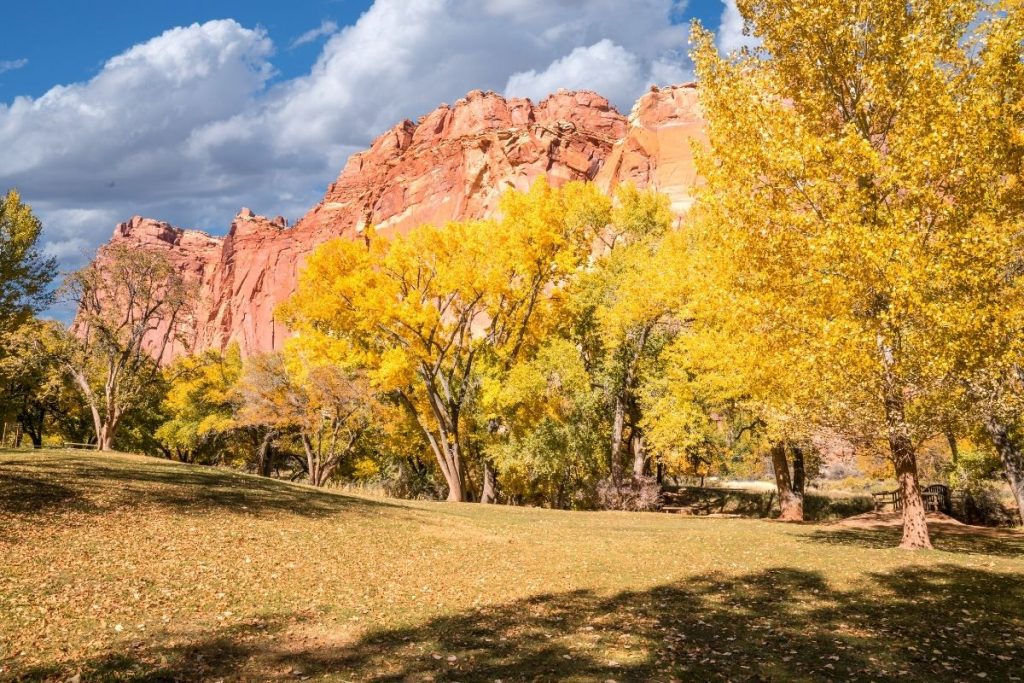
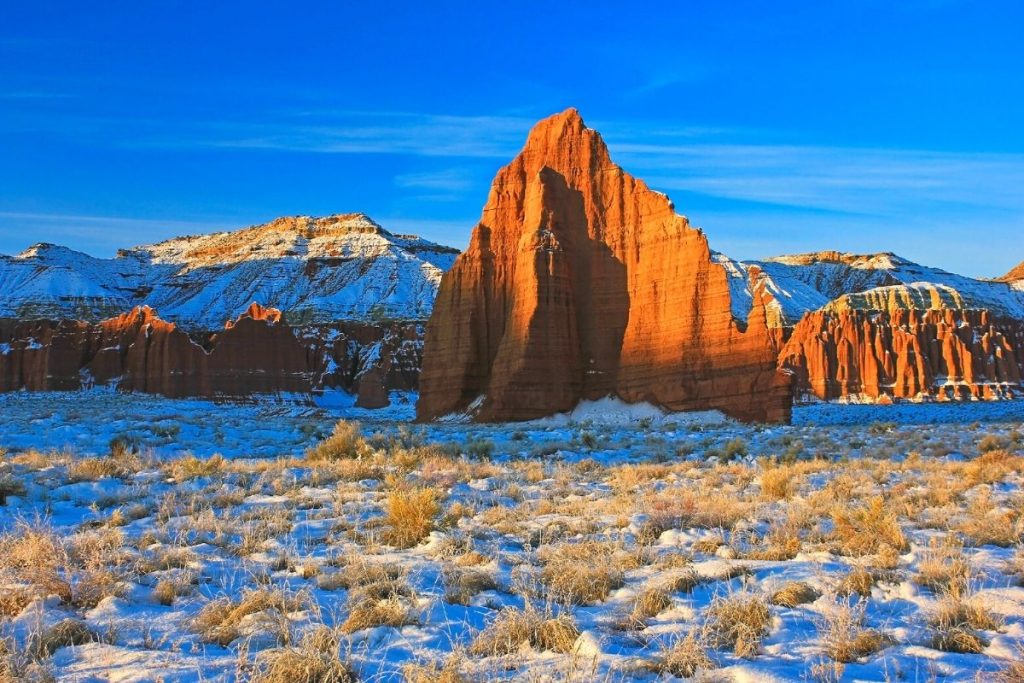
Tips for Capitol Reef Hikes and Scenic Drives
- Get the America the Beautiful National Park Pass. If you’re planning on visiting multiple national parks before or after visiting Capitol Reef, you’ll save money by getting a national park pass. Get your America the Beautiful Pass now for only $80.
- Pack layers. Even in the summer, morning temperatures can be in the 50s or low 60s, so dress in layers to unzip as the day warms up.
- Download maps and trip details offline. Much of Capitol Reef National Park is remote, meaning there’s a high likelihood you’ll be without cell phone service for much of your trip. Download Google Maps for the region offline ahead of time. Offline maps will ensure you’re able to navigate even without cell phone service.
- Always carry an emergency kit for hiking. Even on day hikes, you should be taking the essential hiking gear to survive an emergency night on the trail.
- Keep an emergency roadside kit in your vehicle if you plan to do the longer, remote scenic drives. At a minimum, this should include a first aid kit, an essential tool kit, blankets, a flashlight, and jumper cables. Of course, you should always keep extra water in your car too.
- Fill up on gas before scenic drives. There are not any gas stations on Capitol Reef National Park’s scenic drives. Be sure to fill up in nearby towns like Torrey before heading out for a drive.
- Many scenic drives require all-wheel-drive. Do not attempt scenic drives like Cathedral Valley, Burr Trail Scenic Byway, or Strike Valley Overlook with a high-clearance AWD vehicle as the roads are unpaved and rugged.
Looking for more tips on what to pack for your trip? Check out my guides on the best hiking gear, what to pack for a road trip, and essential camping gear for all my favorite gear picks and tips to make packing for your trip a breeze!
Top Scenic Drives in Capitol Reef
Capitol Reef National Park has excellent activities for any type of traveler. This section covers the five best scenic drives in Capitol Reef National Park.
Don’t miss the best of Utah’s national parks on your upcoming trip! This free, printable Utah national park road trip itinerary covers all the best points of interest in all 5 Utah parks, plus bonus tips on where to stay and side trips to nearby state parks and monuments.
Download your free Utah road trip itinerary here.
1. Highway 24 Scenic Drive
- District: Fruita District
- Estimated Time: 1 to 2 hours

As you approach Capitol Reef National Park for the first time, you’ll likely pass through the ultra-scenic Highway 24. This highway runs through the park’s heart, separating the Fruita and Cathedral Valley districts along the Fremont River.
Start your trip to Capitol Reef with a scenic drive along Highway 24. You’ll pass sandstone cliffs and large rock formations as you approach the historic Fruita District.
Several park attractions on this list, like Panorama Point, Goosenecks Overlook, and Sunset Point, are found along Highway 24.
Capitol Reef National Park doesn’t charge a fee to drive Highway 24, so if you’re looking for a way to tour the park for free, don’t miss this drive!
Read More: Zion to Bryce Canyon 3-Day Road Trip
2. Capitol Reef Scenic Drive
- District: Fruita District
- Estimated Time: 30 minutes to 1 hour
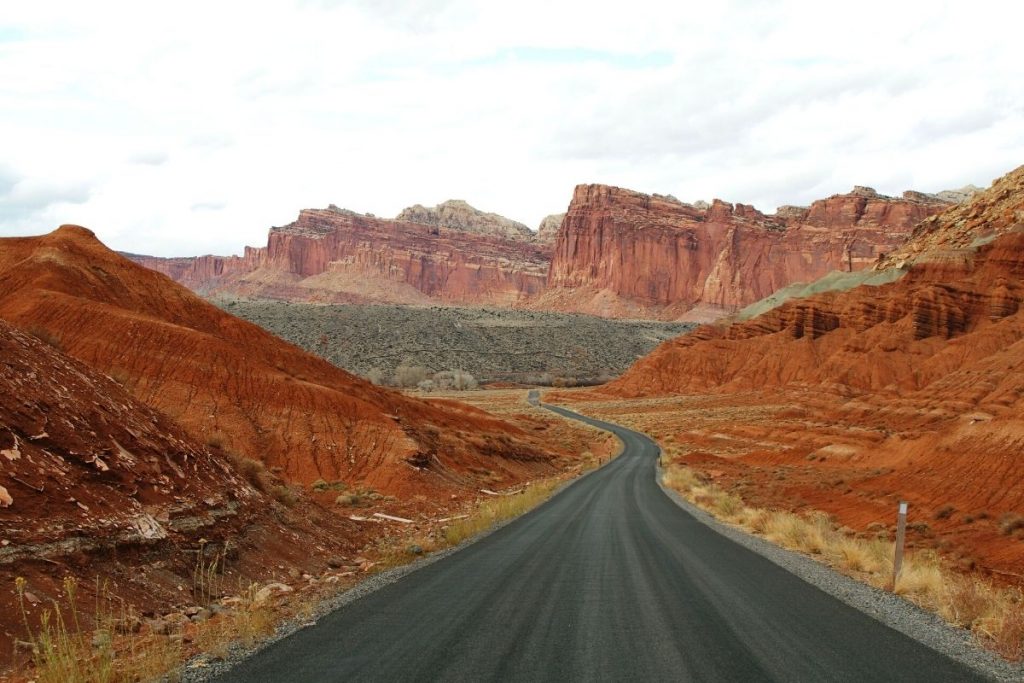
Beginning in the Fruita District and ending at Capitol Gorge Road, Capitol Reef National Park has an excellent 8-mile scenic drive, filled with scenery. More than ten viewpoints along this short drive have must-see views of this park’s historic area.
A few miles into the scenic drive, you’ll reach the turn for the unpaved Grand Wash Road, providing access to popular trails like the Cassidy Arch Trail.
At the end of the 8-mile drive, the unpaved Capitol Gorge Road continues for another 2 miles. If you’re looking to explore with few crowds and hike the Capitol Gorge Trail, I highly recommend continuing (as long as you have AWD).
The scenic drive through the heart of Capitol Reef is the only spot in the park that charges an admission fee. You can buy a national park pass ahead of time or pay your $20 entry fee at the start of the scenic drive or visitor center.
3. Temple of the Sun and Moon
- District: Cathedral Valley
- Estimated Time: 3 to 5 hours
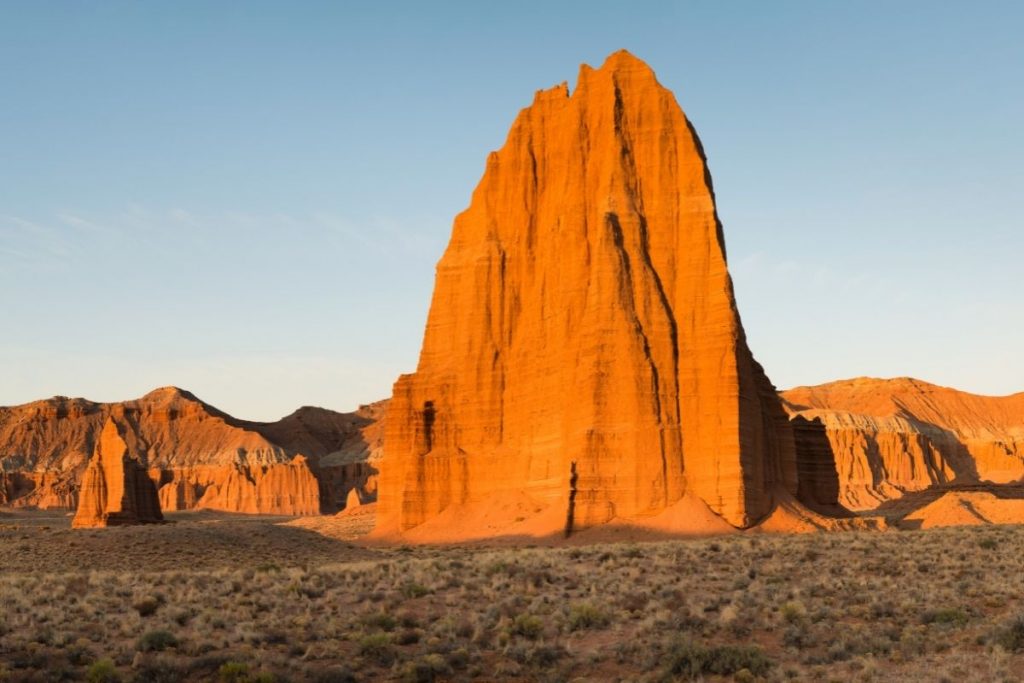
To the north of the Fruita District, you’ll find Cathedral Valley, a rugged and remote district in Capitol Reef National Park. If you’re looking to escape the crowds in the Historic Fruita District, venture out to Cathedral Valley instead.
The roads through this area are rough and unpaved, best suited for AWD vehicles.
One of the best viewpoints in Cathedral Valley is the Temple of the Sun and Moon. These two arrowhead-like giants erupt from the desert landscape in Cathedral Valley.
Best seen at sunrise or in the early morning, the rocks come alive with bright red and orange reflections from the burning sun.
If you have the time and a ruggedized 4×4 vehicle, I highly recommend doing the full 58-mile Cathedral Valley scenic drive. This loop takes around 5 hours and requires fording a river at East Hartnet Road just off Highway 24.
If you’re just looking to visit the Temple of the Sun and Moon, take Caineville Wash Road to Cathedral Road out and back. Plan for this route to take about 3 hours in total.
4. Burr Trail Scenic Byway
- District: Waterpocket Fold
- Estimated Time: 4 to 5 hours

For a true backcountry escape, head to the Waterpocket Fold area. The Burr Trail Scenic Byway passes through several parks, including Capitol Reef National Park, Grand Staircase-Escalante National Monument, and Glen Canyon National Recreation Area.
If you’re staying near the Fruita District, the easiest way to reach Burr Trail is via Notom-Bullfrog Road, an unpaved AWD dirt road leading to Strike Valley Overlook.
You can also connect with the Burr Trail from the south near Natural Bridges National Monument. If you’re making a Utah national park road trip, I highly recommend taking this route!
The Burr Trail Switchbacks are the most famous section of this scenic drive. The harrowing turns up steep elevation is a thrillseekers haven and nerve-wracking for those with a fear of heights.
After passing through the switchbacks, you’ll continue on Burr Trail Road until re-joining Highway 12 in Boulder, Utah. Highway 12 from Boulder to Torrey is another must-do scenic drive in this region.
Read More: 14 Best National Parks in Utah
5. Strike Valley Overlook
- District: Waterpocket Fold
- Estimated Time: 5 to 6 hours
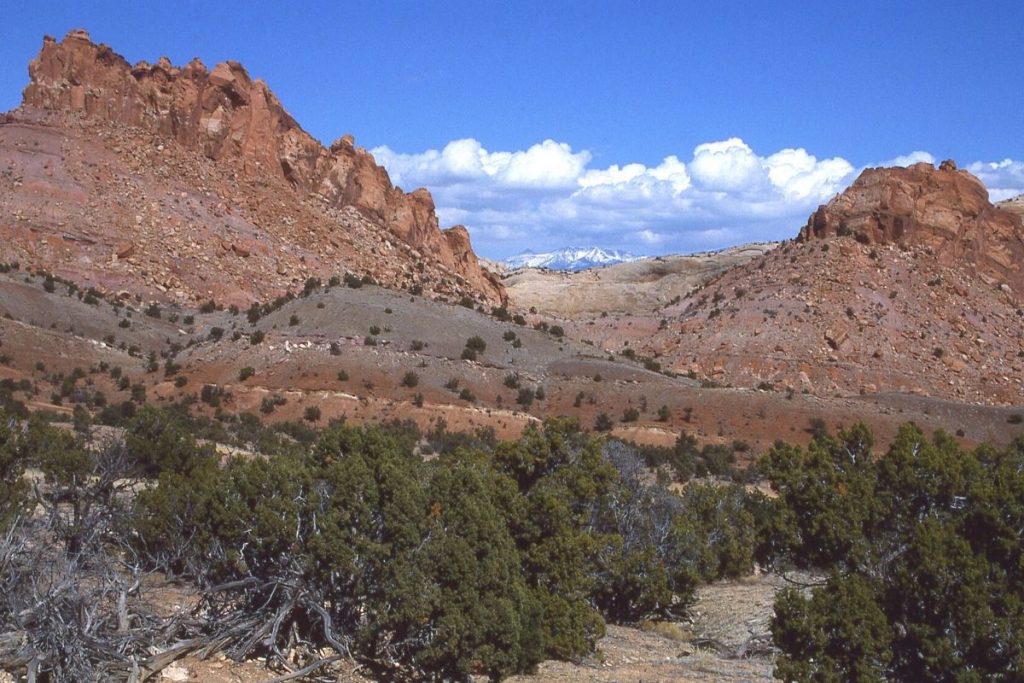
Like the Burr Trail Scenic Byway, Strike Valley Overlook is a remote area of Capitol Reef that few people visit. However, those that do make it here are rewarded with unparalleled views of the geology of the Waterpocket Fold.
You can reach Strike Valley Overlook two ways:
- Highway 12 to Burr Trail Road (coming in from the west) – I recommend this route if you’re not interested in driving the Burr Trail Switchbacks.
- Highway 24 to Notom-Bullfrog Road (coming in from the east) – Recommend this route if you plan to drive the Burr Trail Switchbacks.
The road to the overlook can be rough and only high-clearance, AWD vehicles should attempt it. If you don’t have AWD, you can park along Burr Trail Road and hike the overlook’s 6-mile round trip access road.
What to Do in Capitol Reef National Park for History Buffs
There’s plenty of history of both the indigenous cultures and the settlers found in Capitol Reef. This section covers the best historic areas in the park.
6. Capitol Reef Visitor Center
- District: Fruita District
- Estimated Time: 30 minutes
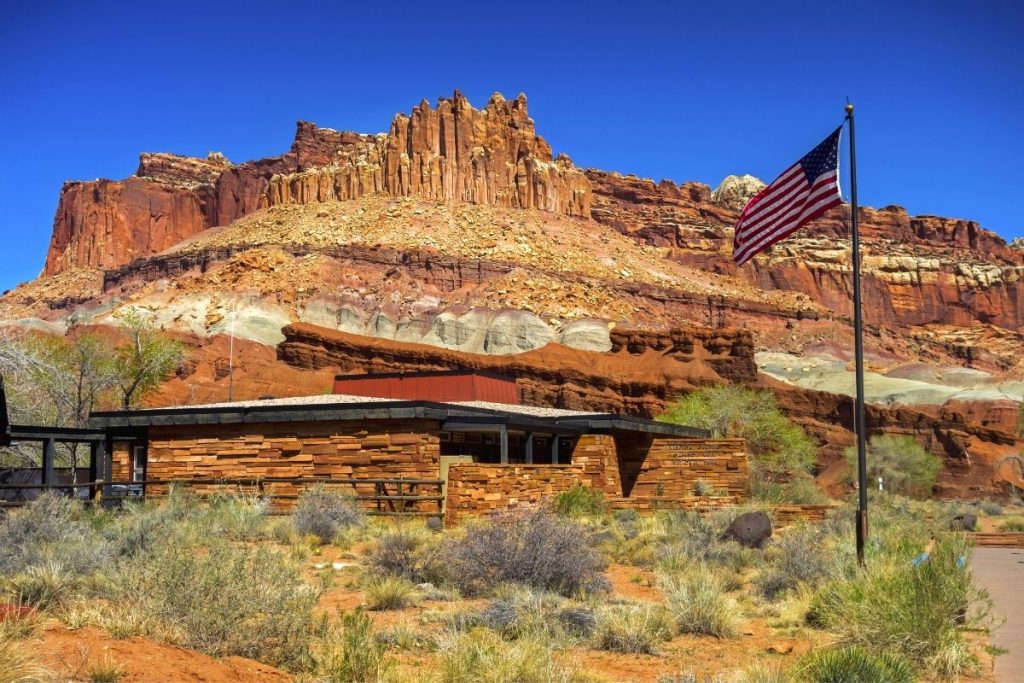
A stop at the visitor center is essential for any national park trip. The Capitol Reef Visitor Center is located in the Fruita Historic District and is open year-round.
Inside the visitor center, you’ll find informational displays and a museum dedicated to the geology and history of the area.
The visitor center is also a great place to speak to National Park Service rangers, get information on the latest road conditions and trail status, and pick up maps, brochures, gifts, and stamp your national park passport!
If you’re traveling with kids, don’t miss the Ripple Rock Nature Center just down the road from the visitor center!
7. Fruita Historic District
- District: Fruita District
- Estimated Time: 30 minutes to 2 hours
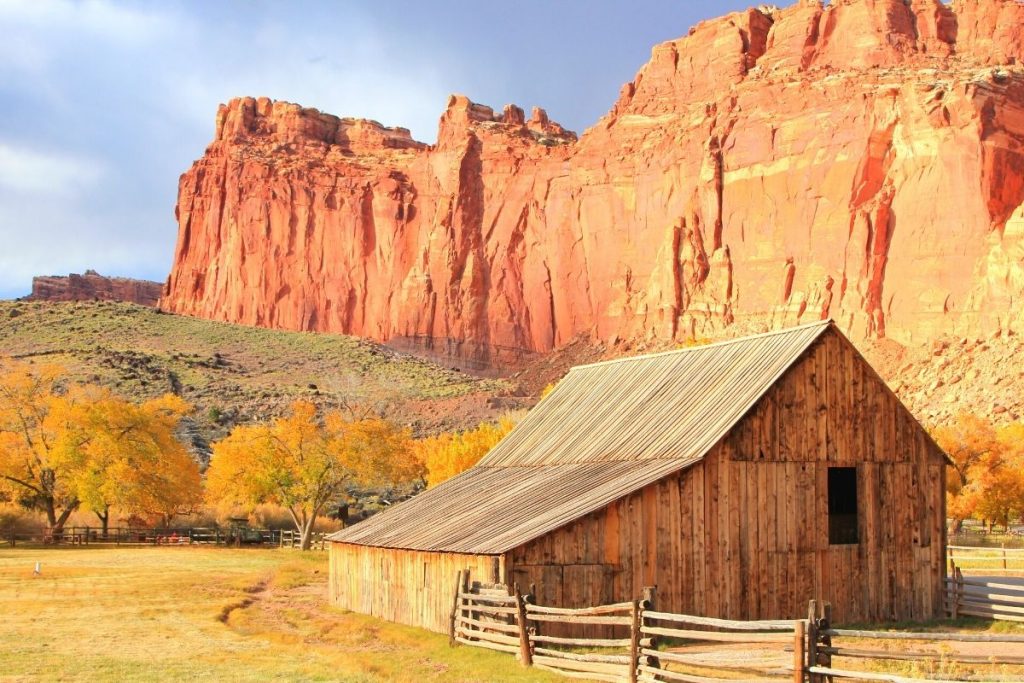
The Fruita Historic District sits at the center of Capitol Reef National Park. The area is home to the visitor center and several historic buildings from the pioneer settlers.
Fruita is surprisingly lush compared to other regions in Capitol Reef as it runs along the Fremont River.
This area is rich with the history of the Mormon settlers in the late 1800s. Today, you’ll find preserved parts of the settlement, including the Fruita Schoolhouse, Blacksmith Shop, Gifford House, and Fruita Orchard.
If you’re visiting in the summer or fall, you can see the Fruita Orchard and harvest your fruit, like apples, peaches, and cherries! Read more about the Fruita Orchard harvest schedule here.
The Gifford Homestead is one of the most visited historic buildings in the Fruita District. The tiny home built in 1908 originally belonged to Calvin Pendleton but 20 years later came into the possession of the Gifford family.
Today, you’ll find one of the best bakeries in the area with exceptional desserts. Be sure to stop in at the Gifford House for handmade fruit pies, as well as soaps, jams, and jellies.
Best Viewpoints and Easy Hikes in Capitol Reef National Park
Capitol Reef National Park has plenty of hikes for all skills levels. This section covers the best viewpoints and easy, short hiking trails in the park.
8. Panorama Point
- District: Fruita District
- Estimated Time: 15 minutes
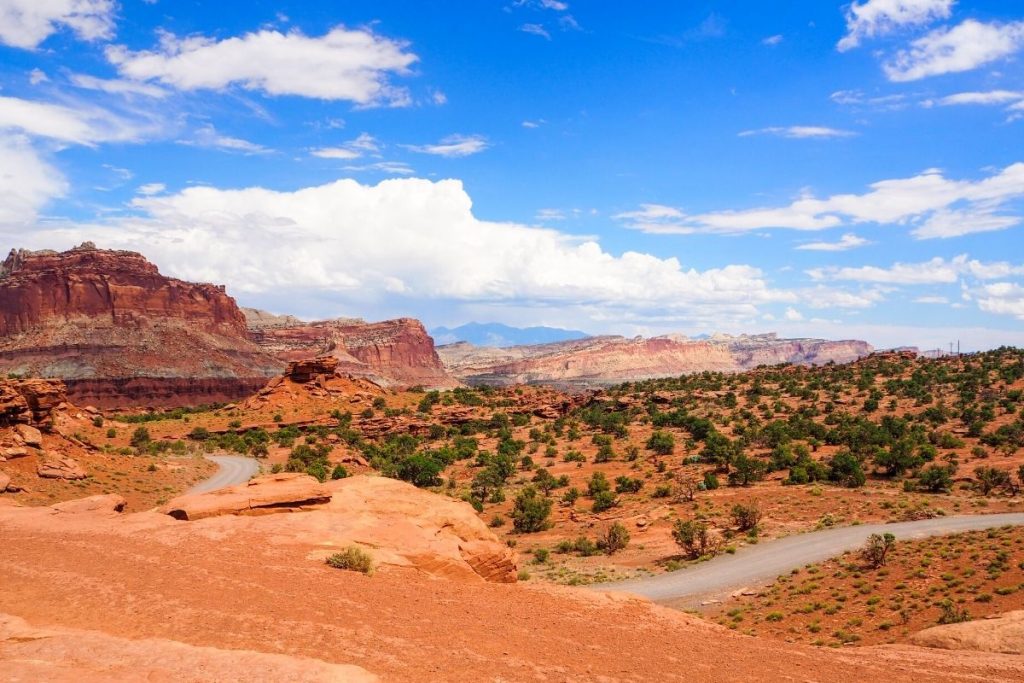
Located off Highway 24, Panorama Point is one of the best viewpoints overlooking Capitol Reef. When heading into the park from Torrey, this is the first major landmark you’ll reach.
This viewpoint serves as an excellent way to start your trip to Capitol Reef, mainly from Bryce Canyon National Park.
From the vista, you can follow the winding outline of Highway 24 through Capitol Reef. You’ll be rewarded with 360-degree views (hence the name Panorama Point!) of the rugged, red landscape.
9. Goosenecks Overlook
- District: Fruita District
- Estimated Time: 30 minutes
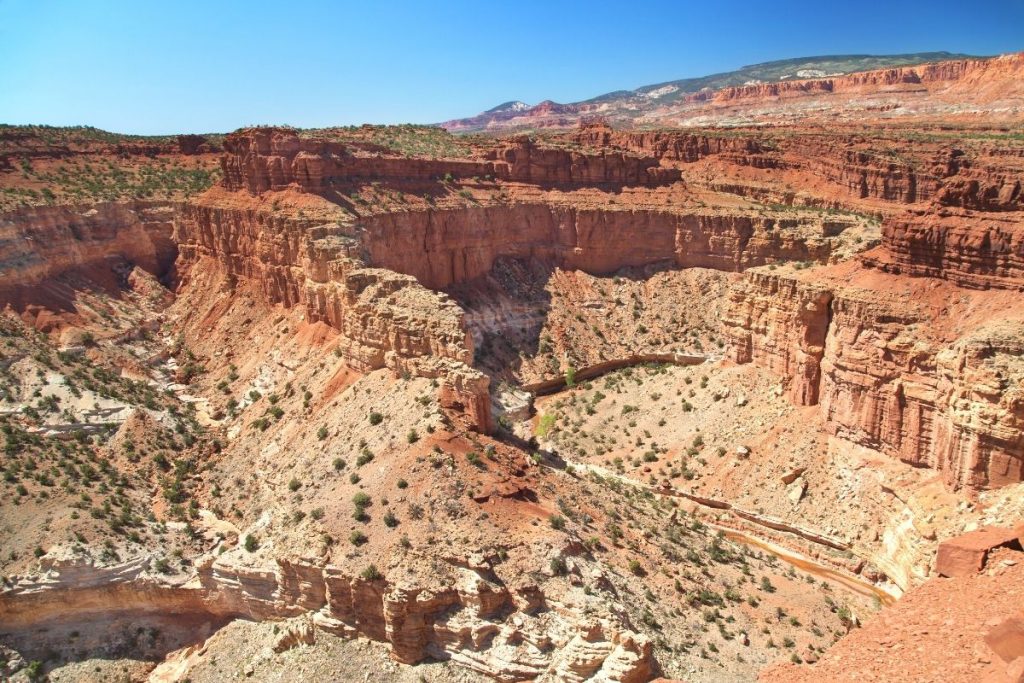
If you continue along the gravel road past Panorama Point, you’ll reach Goosenecks Overlook. While this viewpoint does require a short, uphill walk of 0.2-miles round trip, it’s manageable for most travelers.
The “gooseneck” was formed by a bend carved out by Sulphur Creek below and provides beautiful views of Capitol Reef’s signature red rocks and greenery.
10. Sunset Point
- District: Fruita District
- Distance: 0.8 miles
- Elevation: Less than 50 feet
- Difficulty: Easy
- Estimated Time: 30 minutes
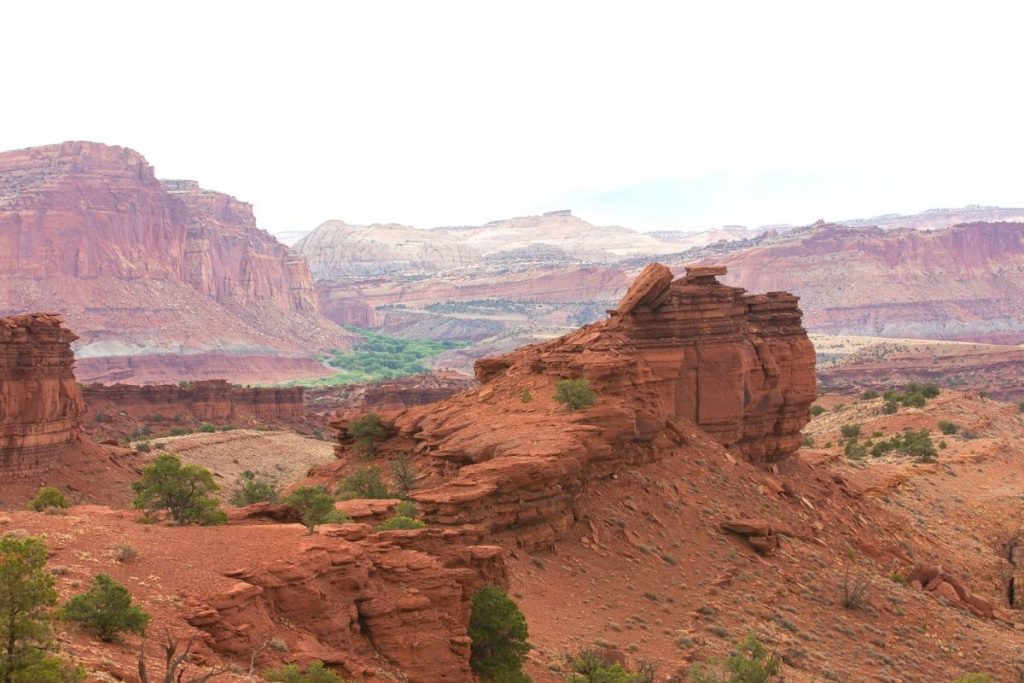
The path to Sunset Point starts at the same parking lot as Goosenecks Overlook. A bit further than the walk to Goosenecks Overlook, the 0.8-mile roundtrip hike to Sunset Point is well worth it, especially for sunset.
If you’re arriving at Capitol Reef in the late afternoon or evening, I highly recommend exploring Panorama Point, Goosenecks Overlook, and Sunset Point for sunset on your first night!
These stunning viewpoints provide an excellent introduction to the landscape of Capitol Reef National Park.
11. Petroglyphs Panel
- District: Fruita District
- Estimated Time: 30 minutes
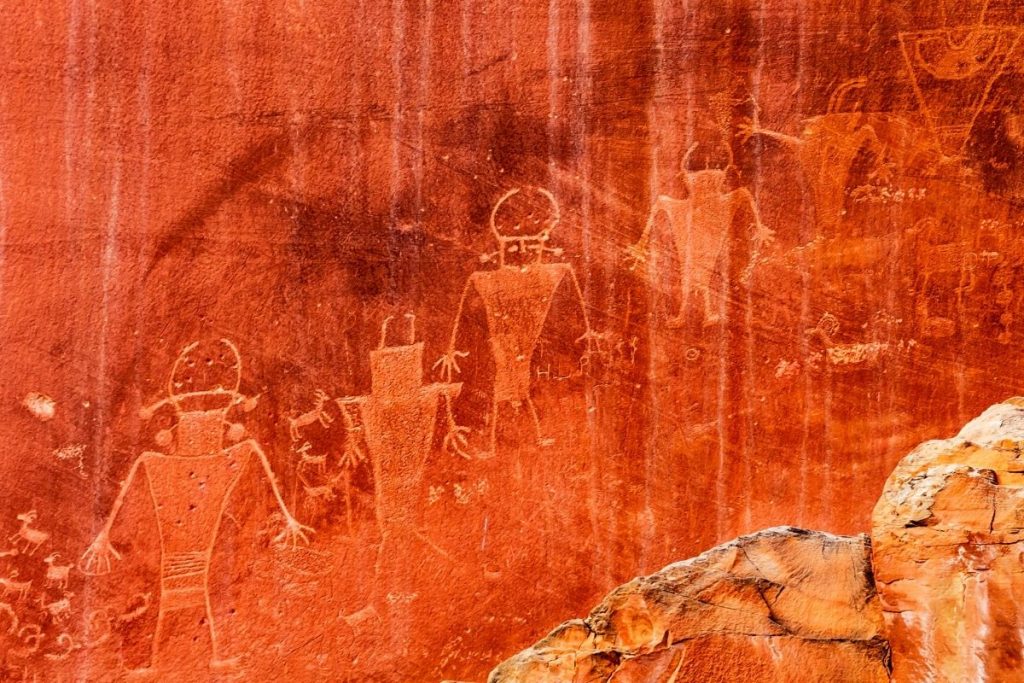
Long before the settlers arrived in Fruita, Capitol Reef National Park was home to indigenous peoples who protected and cared for the beautiful lands you see today.
One of the best ways to glimpse into early human life in this area is with petroglyphs.
Petroglyphs are ancient rock art carvings that tell stories of the Fremont and Ancestral Puebloan people. Just off Highway 24 between Hickman Bridge and Fruita, there’s a spectacular panel of petroglyphs. A short walk to a viewpoint allows you to see the beautiful display.
Want to learn more about the indigenous communities of Capitol Reef? Read more here about the Fremont peoples’ culture and the Ancestral Puebloans.
12. Capitol Gorge Trail
- District: Fruita District
- Distance: 2.0 miles
- Elevation: 80 feet
- Difficulty: Easy
- Estimated Time: 1 hour
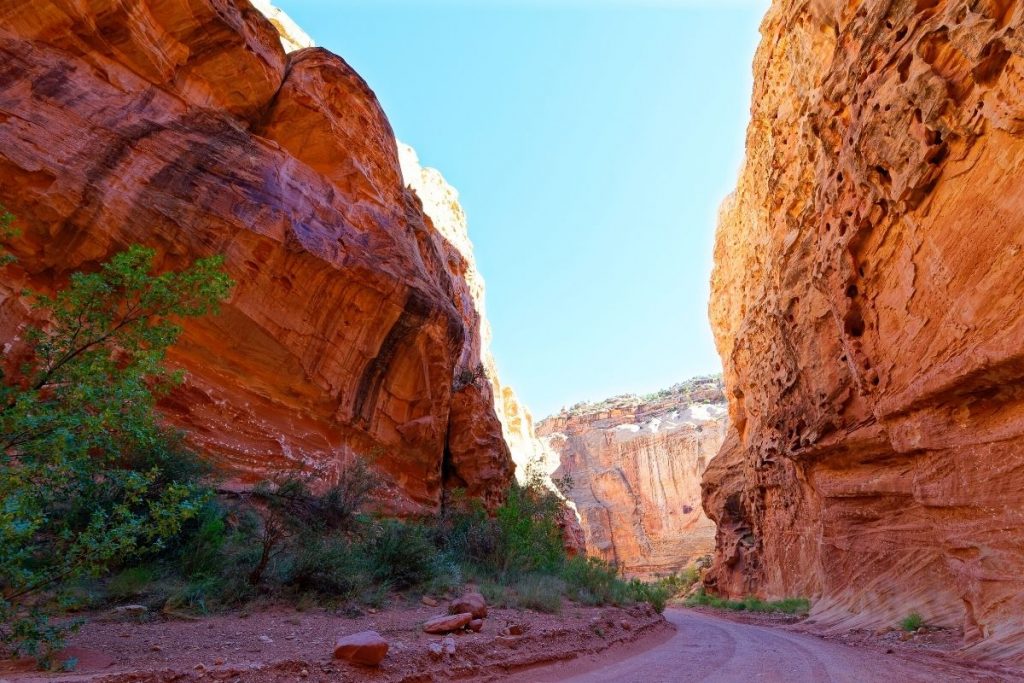
Head to the Capitol Gorge Trail for more evidence of the Mormon settlers that passed through the area in the late 1800s. This hike is home to the Pioneer Register, documentation of travelers carved into the sandstone wall.
The register has the names of the settlers and miners who passed through over a century ago.
The trail starts at the end of Capitol Gorge Road, an unpaved gravel road off the Capitol Reef Scenic Drive. The path winds through the vast and narrow canyons, the only way through the Waterpocket Fold for early settlers.
It’s a 1.5-mile round trip hike to the Pioneer Register, but hikers can continue to see The Tanks, small water pockets that fill with rain to form small pools.
Important Tip
Canyons like Capitol Gorge are prone to flash floods during thunderstorms. Always double-check the weather report before hiking this trail or check in with rangers at the visitor center ahead of time.
13. Grand Wash Trail
- District: Fruita District
- Distance: 4.4 miles
- Elevation: 200 feet
- Difficulty: Easy
- Estimated Time: 2 hours
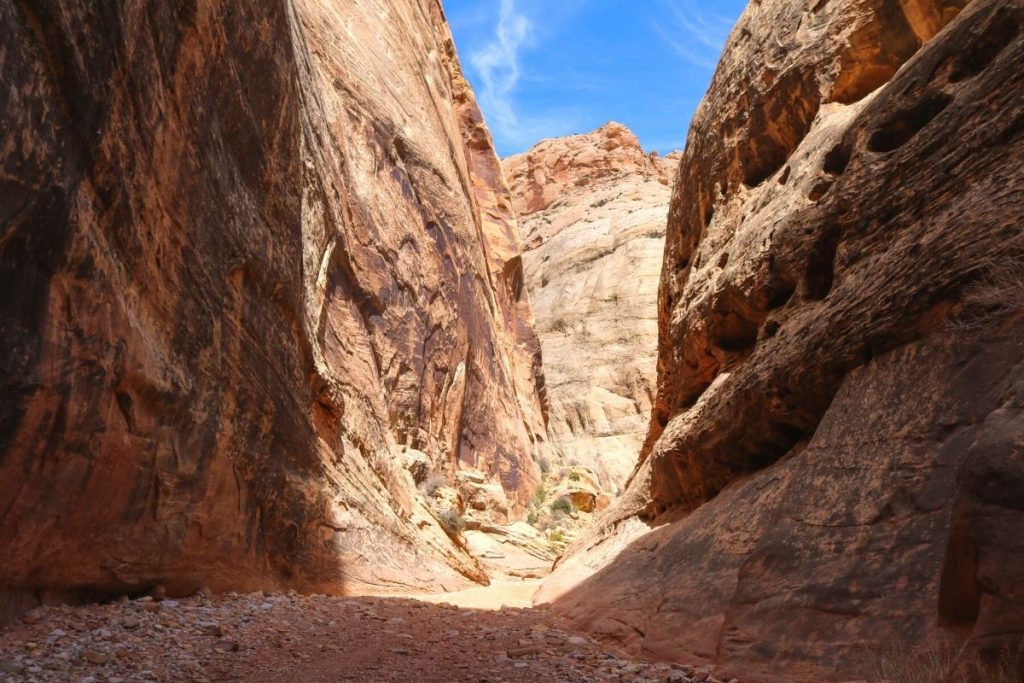
The Grand Wash Trail takes you through Grand Wash, a vast canyon through the Waterpocket Fold. The trail follows a wide sandy canyon, narrowing in parts.
While the entire distance is nearly 5 miles, you can turn around at any point as the path is out and back. Grand Wash Trail spotlights Capitol Reef’s colorful sandstone cliffs and rock formations.
You can hike the Grand Wash Trail from two trailheads as an out-and-back trail:
- Grand Wash Trailhead off Highway 24
- Cassidy Arch Trailhead off Grand Wash Road
About 1 mile into the hike (starting from Highway 24), you’ll reach The Narrows, a section of the trail where the canyon narrows, resembling a more traditional slot canyon.
Important Tip
Canyons like Grand Wash are prone to flash floods during thunderstorms. Always double-check the weather report before hiking this trail or check in with rangers at the visitor center ahead of time.
Moderate & Strenuous Capitol Reef National Park Hiking Trails
Want more of a challenge while exploring Capitol Reef? This last section covers the best moderate to strenuous hikes in Capitol Reef.
14. Cassidy Arch Trail
- District: Fruita District
- Distance: 3.4 miles
- Elevation: 670 feet
- Difficulty: Strenuous
- Estimated Time: 2 hours
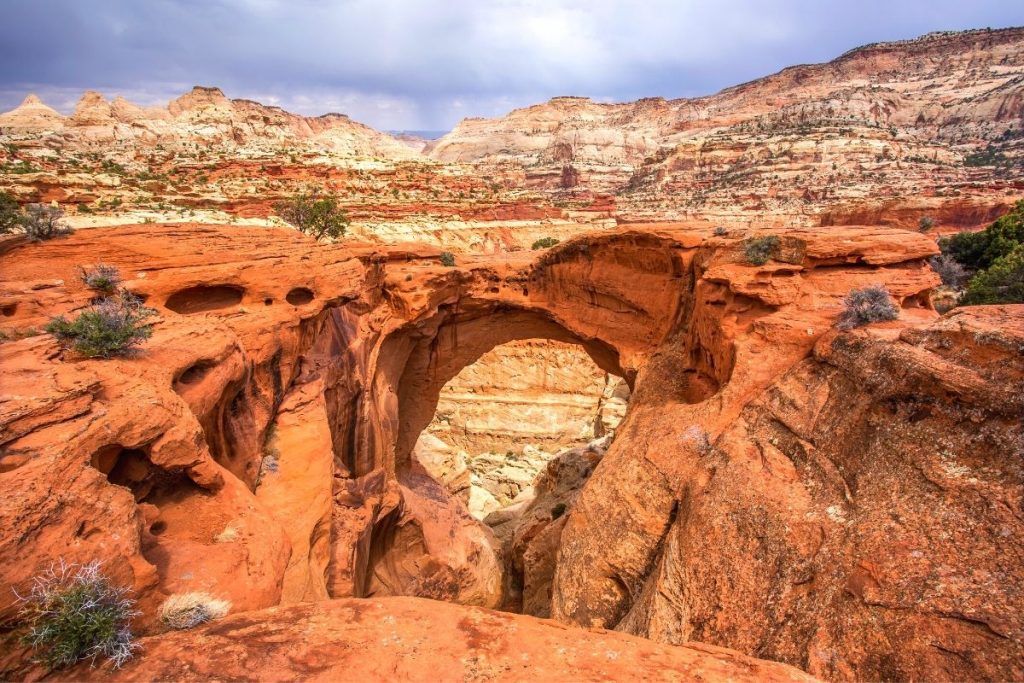
The Cassidy Arch Trail is a moderate hike with spectacular views along the way, making it one of Capitol Reef’s most popular hikes. The trail gets its name from Butch Cassidy, an outlaw from the Wild West who supposedly hid here.
The short detour off the Capitol Reef Scenic Drive along Grand Wash Road leads you to the trailhead.
As you traverse the slickrock trail, you’ll get views above Grand Wash, a famous gorge through the upper part of the Waterpocket Fold, and the Fruita District. At the end of the trail, you’ll find Cassidy Arch (which is a bridge, not an arch!).
This trail can become very slick from snow and ice in the winter, so it’s best hiked from Spring to Fall.
15. Hickman Bridge Trail
- District: Fruita District
- Distance: 1.8 miles
- Elevation: 400 feet
- Difficulty: Moderate
- Estimated Time: 1 hour
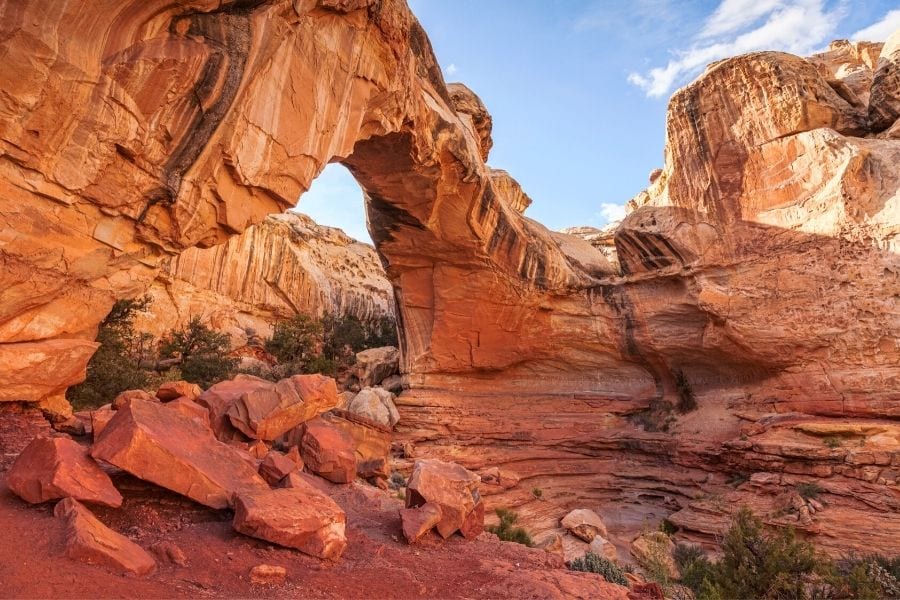
Opt for the Hickman Bridge Trail instead if you’re looking for a more leisurely hike than the Cassidy Arch Trail! This moderate 1.8-mile hike follows the Fremont River out to a viewpoint of the bridge.
This popular natural bridge attracts many visitors, making it one of the park’s most popular hikes. The trail gets its moderate rating from the elevation gain in a relatively short distance.
It’s tough but well worth it for the views of the 133-foot Hickman Bridge.
In the Spring and Summer, you may see wildflowers too. However, this trail can become very slick in the winter from snow and ice, so it’s best hiked from Spring to Fall.
How Much Time Do You Need for Scenic Drives and Capitol Reef National Park Hikes?
Ideally, you should spend at least two days in Capitol Reef National Park to get the whole experience. However, if you don’t have that much time, here are a few ideas on the best way to spend your time in Capitol Reef:
- If you have a half-day, focus on taking a scenic drive of the park along both Highway 24 and the road to Capitol Gorge. Be sure to stop to check out Panorama Point and Goosenecks Overlook and visit the Fruita Historic District.
- If you have a full day, add a hike to your itinerary (I recommend Hickman Bridge or Capitol Gorge) and stop to see the Petroglyphs Panel.
- If you have two days, spend your second day exploring the Cathedral Valley area with a scenic drive to the Temple of the Sun and Moon. Add another hike instead, like the Cassidy Arch or Grand Wash trails if you don’t have an AWD vehicle.
With more time in the park, you can spend more time in the southern Waterpocket Fold area of the park and drive the Burr Trail Scenic Byway.
Frequently Asked Questions About Things to Do and the Best Hikes in Capitol Reef National Park
How much time do you need at Capitol Reef National Park?
To see the best of Capitol Reef National Park, you need at least two days. While you can see just the highlights in about half a day, spending more time in the park allows you to do more scenic drives and hikes.
Can you do Capitol Reef in a day?
You can see the highlights of Capitol Reef National Park in one day. Spend your time on scenic drives of both Highway 24 and Capitol Gorge. Be sure to stop to check out Panorama Point and Goosenecks Overlook, visit the Fruita Historic District, see the Petroglyphs Panel, and hike Hickman Bridge.
Is Capitol Reef worth visiting?
Less crowded than other Utah national parks, Capitol Reef National Park is worth visiting. The park provides the perfect mix of beautiful landscapes, scenic hikes, and historic landmarks, enough to keep any visitor entertained for days.
Final Thoughts on the Best Things to Do in Capitol Reef National Park
While Capitol Reef National Park is the least visited of Utah’s “Mighty 5” national parks, it belongs on any Utah road trip.
No matter how many days you have in Capitol Reef, you’re sure to find something to do, whether it’s a scenic drive or a hike through the beautiful landscape.
These are the 15 best things to do in Capitol Reef National Park:
- Highway 24 Scenic Drive
- Capitol Reef Scenic Drive
- Temple of the Sun and Moon
- Burr Trail Scenic Byway
- Strike Valley Overlook
- Capitol Reef Visitor Center
- Fruita Historic District
- Panorama Point
- Goosenecks Overlooks
- Sunset Point
- Petroglyphs Panel
- Capitol Gorge Trail
- Grand Wash Trail
- Cassidy Arch Trail
- Hickman Bridge Trail
Visiting other national parks in Utah? Don’t miss these guides to nearby Zion & Bryce Canyon!
- Utah Road Trip: 8-Day Utah National Parks Road Trip
- Zion & Bryce Canyon: 3-Day Zion to Bryce Canyon Road Trip
- Hikes in Bryce Canyon: 12 Best Bryce Canyon Hikes
- All Utah Parks: 14 Best National Parks in Utah
Don’t miss the best of Utah’s national parks on your upcoming trip! This free, printable Utah national park road trip itinerary covers all the best points of interest in all 5 Utah parks, plus bonus tips on where to stay and side trips to nearby state parks and monuments.
Download your free Utah road trip itinerary here.
Don’t Forget to Save This Post on Pinterest
